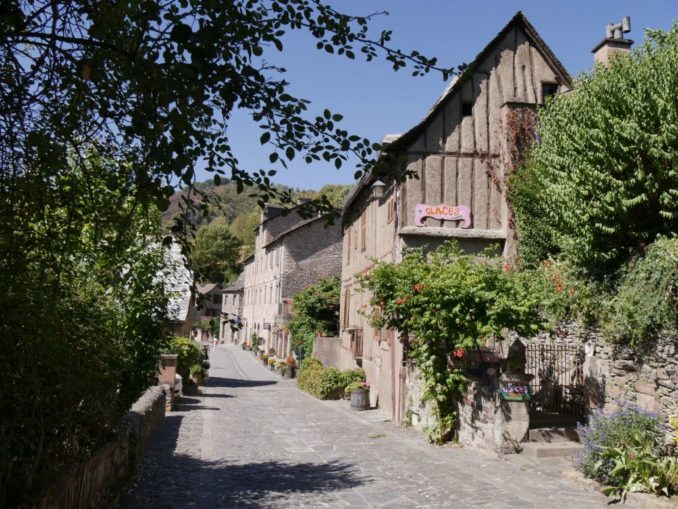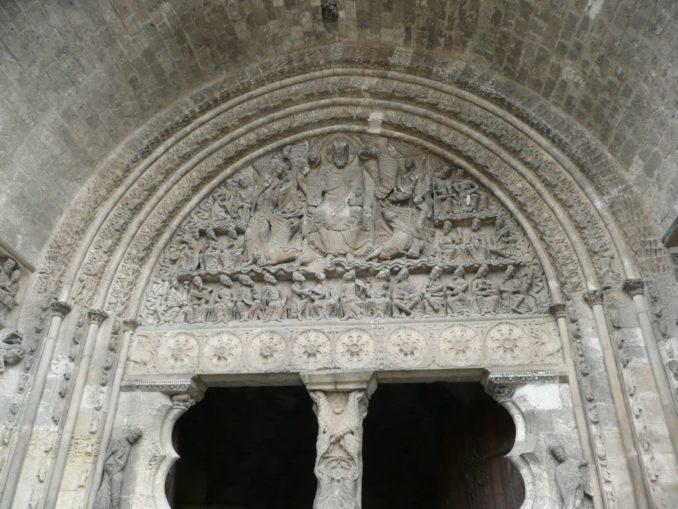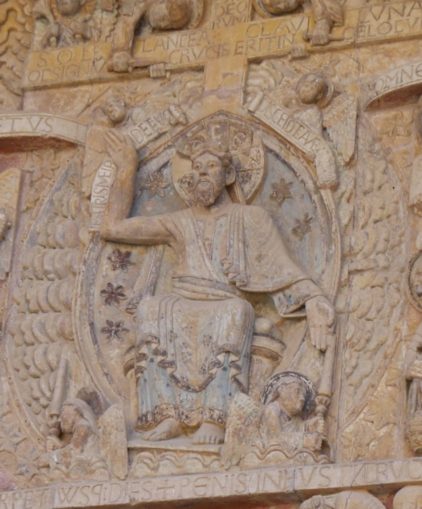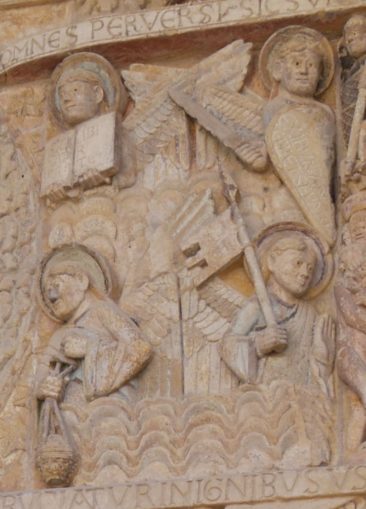
Introduction
Back in the 1990s while returning from a jaunt into Cathar Country in our VW camper, quite by chance we made an overnight stop in the ancient village of Conques in the Aveyron region of France. It was late afternoon by the time we arrived so after getting settled onto our pitch we decided to walk into the village centre to reconnoitre prior to returning the following day for a more leisurely visit and a walk to the viewpoint. Alas, the weather gods were against us and during the night the heavens opened. The torrential rain was forecast to continue for at least another three days so, with flash flooding of the little river on whose banks we were camping a distinct possibility, we reluctantly changed our plans and left the region in search of drier conditions.

At the time we were unaware that Conques is listed as one of the most beautiful villages in France and perhaps because of our ignorance, the impact it made on us as we had walked up the hill towards the Abbey was all the more powerful. It truly is a remarkable place. As we left we made a vow one day to return but it wasn’t until the best part of 25 years had passed that we were finally able to achieve our goal.
Conques – a brief history
The village which lies about 30 kilometres east of Figeac and 35 kilometres north of Rodez is situated on the edge of the gorge of the River Dourdou in wooded and mountainous countryside. Like so many of France’s ‘les plus beaux villages,’ Conques can trace its origins back to ancient pilgrim paths. The settlement there in the 8th Century of a hermit by the name of Dadon, one of whose Benedictine acolytes brought with him from Agen possibly stolen relics of Sainte Foy, shifted the pilgrim trail from Agen to Conques. Sainte Foy (pronounced ‘Fwa’ and usually translated to ‘Saint Faith’ in English) was a 12-year-old girl martyr who had been tortured on a griddle and decapitated at Agen sometime between 297 and 303 for refusing to make pagan sacrifices. Her bones were claimed to cure blindness. Santa Fe New Mexico is named after her.

As the repository of the holy relics, Conques soon became a prosperous stopping-off point on the pilgrimage trail to Santiago de Compostela and construction of the Abbey dedicated to Sainte Foy that began in the 10th century was completed in the 12th century.
Remarkably, Conques has remained largely unchanged over the centuries and still retains its narrow mediæval cobbled streets and ancient buildings.

The Tympanum of the Abbey of Sainte Foy
In an age when ordinary working people were unable to read and write and when church services were conducted in Latin, a language that only the priests could understand, visual representations of the perils that awaited those who sinned carried a very powerful message. From time to time renovation work in ancient English churches leads to the chance discovery and thankfully the preservation of previously unknown wall paintings of the last judgement (known as ‘dooms’) that were whitewashed or plastered over during the Reformation and then simply forgotten about.
These nightmarishly graphic representations of what lay in store for those who strayed from the path of righteousness must have made a powerful impression on the unsophisticated minds of the time. Sometimes, as is the case in St Thomas’s Church, Salisbury, which has the largest and best-preserved doom in England, the scenes are painted on the chancel arch but most appear to have been painted on the west wall where they would be the very last thing the congregation would see as they filed out after the service ended.
In church architecture, a ‘tympanum’ is the usually semi-circular area above the main doors of a building and bounded by a lintel. The iconography is reminiscent of late Roman triumphal arches that depicted Emperors’ victories over barbarians. It is easy to imagine priests pointing out the symbols and explaining their meaning to groups of worshippers.

The last judgement at the Abbey of Sainte Foy is considered to be the best preserved example in the whole of France. A total of 124 carved sandstone figures are represented, all of which would have been brightly painted as is evidenced by the traces of paint that can still be seen. When the depiction was regularly maintained it would have been extremely colourful, much like a modern day comic strip or ‘bande dessinée’.
Don’t miss this short video of an amazing light show that shows how the tympanum would have looked to a mediæval pilgrim. It will take your breath away: Light Show
The tympana at Beaulieu-sur-Dordogne and Moissac are justifiably famous but neither can compare for sheer scale and wealth of detail with the example at Conques and while the message they contain is usually pretty straightforward that is, be good and you will be rewarded in heaven but go against the church’s teachings and this horrific fate awaits you, a little research is needed fully to understand the more subtle meanings depicted.


The Conques Tympanum explained
The Sainte Foy tympanum was created around 1110 and is considered to be one of the finest works of art of the 12th century. Its basic message is the mediæval doctrine of the intercession of the saints.








The Latin inscriptions
There are two main rhyming inscriptions:
SANCTORVM CETVS STAT XPISTO IUDICE LETUS / SIC DATUR ELECTIS AD CELI GAUDIA VINCTIS GLORIA PAX REQUIES PERPETUUSQVE DIES / CASTI PACIFICI MITES PIETATIS AMICI SIC STANT GAUDIENTES SECURI NIL METUENTES
“The company of saints stands happy before Christ the Judge. Thus joy is given in Heaven to the elect. Thus stand the chaste, the peaceful, the meek friends of piety, rejoicing, secure, fearing nothing.”
HOMINES PERVERSI SIC SUNT IN TARTARA MERSI / PENIS INIUSTI CRUCIANTUR IN IGNIBUS USTI DEMONAS ATQUE TREMUNT PERPETUOQUE GEMUNT / FURES MENDACES FALSI CUPIDIQUE RAPACES SIC SUNT DAMPNATI CUNCTI SIMUL ET SCELERATI
“Perverse men are thus sent down to Hell. They are tortured, burned in flames. And they tremble at the demons and groan perpetually. Thieves, liars, deceivers, the greedy and rapacious and criminals – all alike are damned in this way.”
Finally, the inscription across the lintel at the base of the tympanum reads:
O PECCCATORES TRANSMVTETIS NISI MORES IVDICIVM DVRVM VOBIS SCITOTE FVTERVM
“O sinners, know that unless you change your ways there will be a hard judgement.”

In conclusion
I never cease to be amazed that despite centuries of turmoil caused by wars and civil insurrection, so many French towns and villages have managed to preserve their mediæval heritage more or less intact. Town centre buildings that would have long since been demolished in England as part of the post-war slum clearance initiative or have been pulled down simply to make way for wider streets or commercial and residential development are still occupied and preserved. Conques is one of the best examples of this that I have seen and even if like me the jewel encrusted gold statue of Sainte Foy herself leaves you cold, the Abbey is well worth a visit if only to marvel at the skill of the masons who created such an incredible and long lasting monument to their ability.
Acknowledgements
I am indebted to the Christian Iconography web page https://www.christianiconography.info/conques/tympanum.htm for the translation of the Latin texts and explanation of the symbolism. Any errors in transcribing the Latin are mine.
© text & images Tom Pudding 2020
The Goodnight Vienna Audio file



